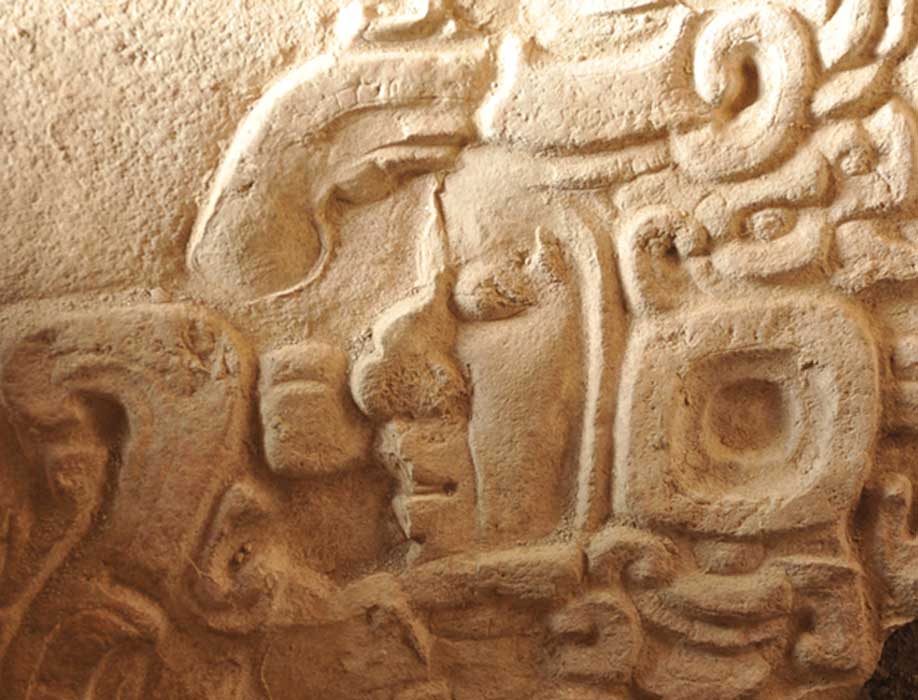Maya Snake King Dynasty Used Local Gods to Gain Authority in Rural Guatemala
Taking political control is often a violent affair, but tactics, knowledge of local customs and beliefs, and trickery can also be used to get an ambitious leader’s foot in the door. New research on the rural Guatemalan La Corona archaeological site show that Classic era Maya Snake Kings took advantage of local beliefs to dominate the population and then transformed the site into an important location in their expansive kingdom.
Researchers came to this conclusion after exploring La Corona through excavations, aerial laser maps, and a series of stone-slab hieroglyphics. Science News reports the scholars were primarily interested in exploring the political side of life in La Corona during the Classic Maya era.

Royal throne effigy; Maya culture, Guatemala, probably La Corona, A.D. 731; 73.5 x 73.2 x 5.7 cm; Limestone. Dallas Museum of Art, Dallas, Texas. (Public Domain)
Archaeologist Marcello Canuto of Tulane University in New Orleans and tour scholar for Far Horizons, has codirected the project with archaeologist Tomás Barrientos of the University of the Valley of Guatemala in Guatemala City. He told Science News “Our work supports the idea that the ancient Maya formed interconnected political systems, not largely separate city-states as traditionally thought.”
Barrientos suggested the Snake Kings of Kaanul probably had knowledge of local gods and used that information to gain authority over the people who inhabited La Corona during the Maya Classic period. He said, “To create a new state, Kaanul rulers manipulated traditional mythology at La Corona and celebrated their connections to deities that had preceded their arrival.”
- The Marvelous Mayan Zoomorph Monoliths of Quiriguá
- LiDAR Lifts the Veil on the Oldest Known Maya Settlement in Guatemala

A Maya jade serpent head pendant. Mexico, Chiapas or Guatemala, 200-900 AD. (Public Domain )
Hieroglyphic inscriptions at La Corona from 314 provide insight on when Maya deities gained prominence there and show local authorities strongly linked themselves to those gods. A stone monument from 546 also names Maya deities in relation to rulers and explains that the settlement was under the control of a large unnamed capital city, which researchers have decided was Calakmul.
Epigrapher Simon Martin, of the University of Pennsylvania Museum of Archaeology and Anthropology in Philadelphia, who did not participate in the study, told Science News that the quantity of stone slabs with hieroglyphics at La Corona is startling and “So much text at such a small site suggests La Corona served as a conduit for sending goods north to Calakmul.”

SMU graduate student Stanley Guenter cleans a panel of Maya glyphs from the archaeological site of La Corona. This particular panel helped point to La Corona as the long-sought "Site Q". The panel's left side depicts king K'inich Yook of Sak Niktem. (Fair Use)
Barrientos believes ritual feasts were likely a part of the process as well, as evidenced by bones of butchered animals in stone pits at the La Corona ceremonial plaza which date to the Kaanul era.
The researchers used Light Detection and Ranging (LIDAR) to explore more than 2,100 square kilometers of the Guatemalan lowlands in 2016. The results show that La Corona was a small but heavily populated settlement with an estimate of 2-3 million people living there between 520-740 AD. That’s the time when the Snake Kings were gaining control over Guatemalan sites and setting them up to be satellites for Calakmul.
- Discovery of Hidden Mayan Stela and Panels Give Hints to the Importance of History in the Preclassical Period
- Oldest Royal Tomb of the Classic Maya Centipede Dynasty is Unearthed in Guatemala

A LIDAR map portrays population densities at La Corona and nearby Classic Maya sites. Red denotes areas with the greatest number of inhabitants. La Corona and sites such as El Peru-Waka’ and Holmul were incorporated into a kingdom that conquered powerful Tikal in 562. (Marcello Canuto, Luke Auld-Thomas, PACUNAM)
Canuto explained the Snake Kings probably used La Corona as a stopping point on the trade network for precious stones and other goods to and from other locations the rulers controlled further to the south. He also pondered if La Corona’s remote location enabled the population to maintain some independence from the Kaanul kings.

Ancient temple in the jungle, Calakmul. (CC BY SA 3.0)
Top Image: Detail of Stela 1, Fragment 1, front. La Corona, Guatemala. Source: David Stuart



















